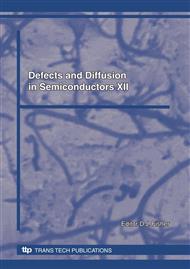p.1
p.7
p.21
p.31
p.39
p.55
p.63
p.85
p.99
Non-Gaussian Diffusion of Phosphorus and Arsenic in Silicon with Local Density Diffusivity Model
Abstract:
In the light of published phosphorus and arsenic diffusion profiles [1,2] a non-Gaussian mathematical diffusion model is developed in this work based on separate forward and reflected impurity diffusion flows and called local density diffusion (LDD) model. The LDD model includes the rational function diffusion (RFD) model published in [3] and represents an improvement for near surface and tail concentration profile slope approximation by introducing just one single empirical fit parameter “r”. This single fit parameter is related to the given combination of impurity species (phosphorus: r=0.18; arsenic: r=0.43) in the applied host lattice system (silicon), but does not vary while approximating different experiments with different impurity surface concentrations and penetration depths [1,2]. Based on the LDD approximation in this work a surface enhanced diffusivity for phosphorus and a tail decelerated diffusion for arsenic is suggested in comparison to RFD model approximation only. The local density diffusivity is found to be non-linear along the penetration path and reaches its maximum at a distance LLDD from the surface.
Info:
Periodical:
Pages:
21-29
Citation:
Online since:
July 2010
Authors:
Keywords:
Price:
Сopyright:
© 2010 Trans Tech Publications Ltd. All Rights Reserved
Share:
Citation:


